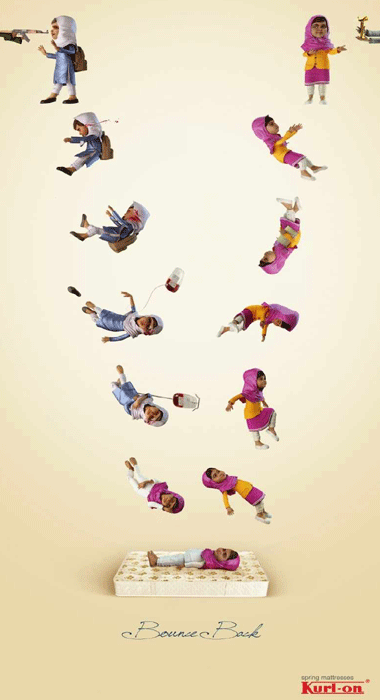This campaign was brought to my notice by a colleague a couple of days ago, asking if I wanted to comment on it.
I dismissed the thought as soon as I saw that the link was to the popular website adsoftheworld, where aspiring creatives upload speculative work. The site is a repository for ads which are most suited for winning awards, but unlikely to be used by a client to sell product or service.
[caption id=“attachment_84926” align=“alignleft” width=“380”] Kurl-on ‘Malala’[/caption]
Kurl-on ‘Malala’[/caption]
The broad common elements are along these lines: a clever, short headline, a visual pun, lovely illustration and the absence of body copy.
Without exaggeration, all the copy on all the ads on a single page of adsoftheworld will contain fewer words than the average front page solus ads in a daily newspaper.
These ads often ride on a popular, current, global wave, making it easier for international juries to identify with them.
Last year, we saw the ill-fated Ford Figo ads.
This time around, it’s the turn of Kurl-on.
The Ford Figo ad resulted in the resignations of Bobby Pawar as chief creative officer from JWT India, a senior Ford India executive and a few more from both JWT India and Ford India.
[caption id=“attachment_84928” align=“alignleft” width=“380”] Kurl-on ‘Steve Jobs’[/caption]
Kurl-on ‘Steve Jobs’[/caption]
None of those resignations were necessary.
No resignation is required from either Kurl-on or from Ogilvy in the current instance either.
The inclusion of Malala in the Kurl-on campaign is stupid - but that’s all it is.
In the three creative campaign, two of the ads, the Steve Jobs one and the Gandhi one, undoubtedly make one smile and tick off all the boxes for awards. If Malala wasn’t part of the campaign, however, the campaign loses its sting.
It’s the Malala ad which makes the campaign noticeable.
From the Kurl-on, perspective, however, it’s brilliant. For a mattress to be bracketed indelibly with the word ‘bounce’ is a dream come true. In the Kurl-on instance, the client is delighted - and furiously rejects that the campaign is scam, even though it hasn’t been released in mainstream media yet.
But it didn’t need Malala. Perhaps more time could have been spent in trying to look for other instances of bouncing back without reference to violence.
[caption id=“attachment_84929” align=“alignleft” width=“380”] Kurl-on ‘Gandhi’[/caption]
Kurl-on ‘Gandhi’[/caption]
For example, Yuvraj Singh works, bouncing back from his cancer. One could list more, but there’s no need.
The uproar that we see today (and saw last year in the case of Ford) is something that we could not have seen in a pre-digital world. The ads would have been seen only at advertising awards shows and by the juries, and not by the lay person. Advertising professionals would have viewed the ads in perspective, thought that the ads were clever, and that would have been the end of that - but the non-advertising consumer of digital media would never have seen, or even heard of, these ads.
That’s the difference - and that’s why the inclusion of Malala becomes stupid. Today, from our suffering photos of cats and dogs on our Facebook pages, it takes little for anything, including hateful, spiteful and ill-informed opinion to go viral.
The Malala ad was bound to go viral.
That’s the lesson from both Ford and Kurl-on - scam ads will be seen by a world beyond advertising, exactly the opposite of scam ads in a pre-digital world, when they were published in a remote, low circulation newspaper and seen by none.
This is a new world, a world that creative professionals have to acknowledge. Ad agency management should sensitise creatives on the changed world and be constantly conscious that nothing is private any more.
But unless an ad is irresponsible, the withdrawal of the ad should be the end of the matter. In the Kurl-on case, one could question the use of Malala, but that’s only be a difference of opinion with the creators, it’s not any kind of crime, let alone a hanging one.
Anant Rangaswami was, until recently, the editor of Campaign India magazine, of which Anant was also the founding editor. Campaign India is now arguably India's most respected publication in the advertising and media space. Anant has over 20 years experience in media and advertising. He began in Madras, for STAR TV, moving on as Regional Manager, South for Sony’s SET and finally as Chief Manager at BCCL’s Times Television and Times FM. He then moved to advertising, rising to the post of Associate Vice President at TBWA India. Anant then made the leap into journalism, taking over as editor of what is now Campaign India's competitive publication, Impact. Anant teaches regularly and is a prolific blogger and author of Watching from the sidelines.
)